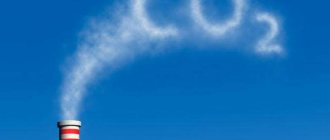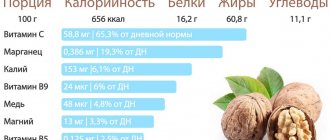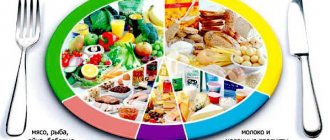How does alcohol behave when it enters our body?
Everything is very simple!
When you just take any alcoholic drink into your mouth, it already begins to be absorbed into the blood, and this happens directly in the oral cavity, and then in the stomach. If it enters the body along with any food, then this process slows down a little, so when you snack, you get drunk a little slower. As a rule, alcohol molecules are broken down both in the stomach and intestines, and the food that came along with them “awaits” its turn. This leads to the fact that fats have time to quickly “hide” in secluded places, because a slow metabolism significantly reduces the rate of fat breakdown.
How then to take this drink? On an empty stomach? In no case - almost all nutritionists say. Alcohol is a powerful appetite stimulant. And this is the most important reason to give up any alcoholic drinks while dieting.
Did you know that alcohol has a diuretic effect? Oh, no need to talk about beer now. Literally all alcoholic drinks, to some extent, dehydrate the body, removing all useful substances with urine.
On a note
Today there is a certain opinion about which alcohol is the lowest in calories. This is a red wine with a calorie content of 65 kcal, which is often used for medicinal purposes. Why can you drink this type of alcohol? Red wine ensures slow absorption into the systemic bloodstream, while cleansing and dilating blood vessels, normalizing blood circulation and blood pressure.
In order not to violate the chosen diet, it is recommended to individually count the calories consumed, and for this you always have a special table at hand. Such an accurate calculation will allow you not only to quickly lose weight, but also to feel great, without worrying about the state of your stomach and the negative effects of ethanol on the nervous system.
To once again make sure that the chosen diet is correct, it would also not hurt to have an individual consultation with a nutritionist with a clearly defined list of permitted alcoholic beverages.
Drink alcohol correctly and it will not harm your figure!
In order for alcohol molecules to cause minimal harm to our health, it is necessary to ensure that they are absorbed very slowly. How?

Now you will understand this:
- Never mix it with carbonated drinks, and also limit the amount of champagne or cocktail you drink. As you know, beer contains carbon dioxide, due to which this drink is classified as one that is slowly absorbed.
- As an appetizer, choose something more substantial than all kinds of cuts. A piece of boiled meat is ideal for allowing alcohol molecules to be absorbed more slowly.
- If you prefer alcohol-containing drinks, then choose one that contains less alcohol.
- Cocktails prepared in cafes are a source of excess sugar, and this is all due to the fact that they mix so many different drinks.
- Before drinking any alcoholic beverage, drink several glasses of water. Thanks to this, you will not only not “overdo it” with alcohol, but also refrain from additional portions of salad or meat.
- Drink alcohol in small doses.
- And, of course, choose the least calorie drink!
Root of Evil
Oddly enough, girls are especially at risk. They are the ones who usually choose sweet alcoholic drinks. Men are rarely interested in such cocktails, preferring if they dilute alcohol, then only with ice. Therefore, the first misconception is to look for the lowest calorie alcohol among the lightest drinks.
How are cocktails made? Often this is strong alcohol (vodka, cognac, rum), which is the highest in calories, mixed with sweet juices and soda. Sometimes condensed milk, various syrups, chocolate, eggs, ice cream are added to this, which only increases the load on your liver and the risk of a sharp increase in body weight.
Top 10 low-calorie alcoholic drinks
The table, which shows the lowest calorie drinks, will help you very quickly figure out how many calories are in the product you have chosen.
| Place | Drink name | Calorie content |
| 1 | Light beer | This drink is considered low-calorie, because 100 grams of the product contains 60 kcal. The only problem is that it is consumed in larger quantities than stronger drinks. |
| 2 | Dry wine | It ranks second in calorie content - 70 units. And besides, it contains tannins, which, in turn, slow down the process of absorption of alcohol molecules. |
| 3 | Semi-dry wine | Its calorie content is 78 units. |
| 4 | Dry champagne | It has a calorie content of 85 kcal. By the way, the presence of “bubbles” in a glass of champagne does not have a very good effect on your body |
| 5 | Semi-sweet wine | Here – 90 kcal. |
| 6 | Sweet wine | The calorie content of such a drink is about 100 kcal. |
| 7 | Dark beer | Its calorie content is the same as the previous contender - 100 units. |
| 8 | Semi-sweet champagne | It already contains 120 kcal. |
| 9 | Vodka, cognac, whiskey, brandy | Imagine, 100 grams of these products contain approximately 240 kcal. |
| 10 | Liqueur, liqueur-based cocktails | This is the highest calorie alcoholic drink. If you drink 100 grams, at least 300 kcal will be added to your body. |
That's it! Therefore, at various feasts, choose the “right” alcoholic drinks so as not to add a couple of extra pounds.
Beer has pitfalls
As a rule, all types of beer include monosodium glutamate, which today is very zealously discussed by all those who promote a healthy lifestyle.
This famous supplement is today credited with causing a huge number of all kinds of diseases, some of them quite serious. Therefore, if you still decide to have a glass of beer with friends, then do not buy store-bought snacks. The best option for a beer snack is fish prepared at home. You can try dietary meat, which will only slow down the process of absorption of alcohol molecules. It is important to remember that beer that contains a large amount of alcohol will also add more calories to your body.
In addition to all of the above, I would like to note that people do not drink one hundred grams of beer per evening. At least 500 ml, which is already from 250 to 400 kcal. The carbon dioxide present, according to research, has a very detrimental effect on the functioning of the liver and cardiovascular system.
Therefore, do not be too fooled by the fact that beer is the lowest-calorie alcoholic drink. And if you really want to drink something with a strong degree, then a glass of dry wine is what you need.
Briefly about the main thing
So, to summarize, I would like to note the following:
- Medical research shows that light beer is the lowest-calorie alcoholic drink. However, you should not lean on it. Firstly, its calorie content is low in relation to 100 grams of product, and the amount of beer consumed, as a rule, reaches at least 0.5 liters. Secondly, it contains harmful additives that can cause some serious diseases.
- Don’t forget to have a good meal after drinking a glass, and preferably not with fast food, but with healthy and proper food. This will slow down the absorption of alcohol molecules into the blood.
- Remember, even if you drink a low-calorie alcoholic drink, it will still stimulate your appetite.
- In general, if you have the opportunity, then give up alcohol completely. This way you will help your body receive only vitamins and beneficial microelements from the food and drink you eat.
Alcohol – friend or foe?
It turns out that everything depends not even on the choice, but on the amount of drink. Looking at the lowest calorie alcohol (the calorie table helps you count with amazing accuracy), we see that it is light beer. 100 g contains about 40 kcal. Even less in non-alcoholic beer, about 33 kcal. However, remembering the culture of drinking beer, it is necessary to remember about fish and cheese, sausage, crackers and nuts.
Indeed, if the first problem is stopping in time, then the second is related to the fact that alcohol is served. Most often this is meat, especially in combination with dough, salads with mayonnaise, cold cuts, lard and bread. It is believed that the stronger the alcohol, the fattier the snacks should be. It is believed that alcohol neutralizes fats.
The best snacks will be vegetable salads, boiled or baked meat and fruits. And this applies to any alcohol, no matter what you choose. Better yet, give up alcohol completely. You won't lose anything, and it will be much easier to keep your figure in shape.
History of alcohol
According to legend, the first alcoholic drink appeared by chance, and it happened about 5 thousand years ago. People picked grapes and squeezed out the juice. In the sun it turned sour, and the fermentation process began. Gradually, experimenting, they began to purposefully speed up this procedure with the help of honey and yeast, raising the alcohol strength to 10 degrees and above.
In 860 AD, the first vodka appeared in the east, which was called “Al-Kegol”, which translates as “intoxicating”. Each civilization has its own methods of obtaining and preparing alcohol. Initially, it was not intended for widespread use, but was used in religious rituals as an integral part of medicines and for water disinfection.
The first mention of whiskey dates back to 1405. It began to be produced by monks in Ireland. It is believed that it appeared several centuries earlier, however, it is not known who and where was the first to distill it.
Recipes for making beer, which were found during archaeological excavations in Egypt and Mesopotamia, date back to the 6th century BC. Residents of Rome and Greece did not favor it, considering it a drink of barbarians, and opted exclusively for wine. In Germany, beer was brewed from wheat, rye and barley. The first brewery was built in the 14th century.
Cognac owes its appearance to economy. In the 16th century, due to overproduction and deteriorating quality of wine, it became impossible to transport it over long distances. Then the Dutch, who were mostly involved in transportation, try to distill it and achieve success. This is how cognac and brandy appear, which can be transported in oak barrels and consumed without diluting.
Numbers
So, every alcoholic drink has calories and contains carbohydrates. You can neglect the indicator of proteins and fats, which are practically not present in alcohol. For example, a liqueur such as Baileys contains only 3 grams of protein and 13 fat per 100 grams. And dry wines do not contain fats, carbohydrates or proteins at all.
Calorie content of alcoholic drinks
| Drink | Number of kcal. per 100 gr. |
| White sweet wine 13.5% | 98 |
| White wine 12% | 78 |
| Dry white wine 12% | 66 |
| Red wine 12% | 76 |
| Red semi-sweet wine 12% | 80 |
| Cognac 40% | 239 |
| Whiskey 40% | 220 |
| Beer 4.5% | 45 |
| Port 20% | 167 |
| Gin 40% | 220 |
| Rum 40% | 220 |
| Vermouth 13% | 148 |
| Baileys liqueur 17% | 327 |
| Martini 13% | 145 |
| Brandy 40% | 227 |
| Tequila 40% | 210 |
| Vodka 40% | 235 |
The highest calorie alcohol is liqueur, because it contains a lot of cream, sugar, milk and eggs. It is recommended to consume in small doses and not snack. According to the table of caloric content of alcohol, wine and, oddly enough, beer have the lowest values. Why is it believed that a person who often uses it actively gains weight? The fact is that beer is drunk in much larger quantities than any other alcohol. One liter contains about 500 kcal. Another thing is that beer is rarely consumed on its own, but is almost always consumed together with food:
- chips;
- crackers;
- dried fish and squid;
- meat.
And this is not a complete list of possible snacks. Perhaps no other drink is consumed with so much fatty food, which is the reason for weight gain.
The number of calories does not reflect harm or benefit. All alcoholic drinks have a bad effect on the human body, can lead to serious diseases, and create alcohol dependence. Therefore, doctors recommend drinking rarely and in small doses.
Wines are low-calorie and have virtually no effect on weight; it is not for nothing that Europeans prefer to drink them for dinner and even lunch (the tradition is to have a glass during lunch). Like fermented milk products, the drink has a good effect on microflora and intestines. The usefulness of quality wines is a scientifically proven fact.
It is usually consumed together with meat, fish dishes and fruits. It is also used as an aperitif, that is, to increase appetite before eating. Drinking half a glass before lunch will improve the digestion process, warm you up a little and relieve cramps.
If we talk about benefits, it is better to choose dry white, it contains a large amount of useful microelements and vitamins, which:
- establish healthy acidity in the stomach and help the digestion process;
- increase liver secretion, which helps eliminate toxins and waste and reduce fermentation in the intestines;
- increase the absorption of iron obtained from food, which speeds up metabolism, improves blood composition and human well-being.
Dry wine, 65-75 kcal
This is a noble drink, without which a celebration is rarely complete. Tasty, invigorating, good wine fills with the energy of the sun, which once illuminated the juicy berries ripening on the vine. Doctors agree that a glass or two of good wine has a positive effect on health. All this is true, but this does not mean that you will not gain excess weight.
Dry Georgian wines are an ideal option for those looking for the lowest calorie alcohol. Everyone can sketch out the list themselves: “Kakheti”, “Chkhaveri”, “Tsinandali”, “Rkatsiteli”. All these are low-calorie light drinks, somewhat tart in taste. If you want to further reduce threats to your figure, then dilute with mineral water with or without sparkling water.
Semi-dry - 78, semi-sweet - 88, sweet - about 100. It is believed that wine is even beneficial in small quantities. This is a natural product obtained by fermenting grapes. Thanks to its composition, it has a beneficial effect on cardiac activity, thins the blood and removes radionuclides, regulates acidity and normalizes metabolic processes.
You can consume no more than 150 ml per day. Dry wine is the best choice for those watching their figure. And some diets even include its use in their menu.
We suggest you read: Alcohol and hypertension: how alcohol affects blood pressure
Strong alcohol
For any alcohol with a degree above 38, the normal dose is no more than 50 grams per day. In such quantities, strong, high-quality alcohol will be beneficial for the body. These alcoholic drinks are high in calories, each containing more than 200 kcal. per 100 gr.
Vodka
Aqueous-alcoholic liquid that has no distinct color or odor. The strength is usually in the range of 39–50 percent. Calorie content per hundred grams ranges from 200 to 250 kcal. The minerals that make up vodka are calcium, potassium and sodium. More often than other types of alcohol, it is used as a disinfectant. When applied externally with a compress, it acts as an antipyretic. Consuming no more than 30 grams per day can reduce blood cholesterol. It is not recommended to combine it with medications.
A strong alcoholic drink made by fermenting and then distilling cane syrup or molasses. It is then usually aged in oak barrels. It matures faster than cognac and whiskey. More often, rum is the basis for many alcoholic cocktails, and is not consumed in its pure form. It is also used for making desserts, for example, fruits are soaked in it, and is often used with coffee and chocolate. In addition to molasses or cane syrup, yeast and flavoring agents are added when making rum. Depending on them, the chemical composition of the product will change slightly. Rum contains small amounts of minerals, for example:
- maltose;
- potassium;
- glucose;
- phosphorus;
- dextrin.
Available in small quantities:
Rum is a fairly high-calorie drink (220 kcal per 100 g), so it goes very poorly with weight loss. It has a good effect on digestion, compresses help treat radiculitis and rheumatism. Rum also has antibacterial properties, relieves nervous tension, treats bronchitis and sore throat (it is recommended to mix with honey and lemon).
The main feature of this drink is hidden in the recipe. An essential component is juniper, the beneficial properties of which have been known to mankind for a long time. Some gin producers experiment and add individual aromatic components and dilute them with spices:
High-quality gin contains the following beneficial elements:
- zinc;
- phosphorus;
- copper;
- sodium;
- potassium;
- manganese;
- iron.
Gin is the same high-calorie drink as rum (220 kcal per 100 g). Don't overuse it if you want to lose weight.
Tequila
Strong Mexican drink. Made from the heart of the agave plant. Contains a lot of inulin. Reasonable consumption improves digestion, reduces the risk of heartburn, heaviness and other uncomfortable conditions. Polymers of fructose molecules that tequila contains increase the number of lactobacilli and bifidobacteria in the body. Calorie content: 210 kcal.
Whiskey
This high-quality alcoholic drink has many benefits:
- Improves brain function. Provides prevention of Alzheimer's disease.
- Reduces stress and risk of stroke.
- Great for diabetics as it contains no carbohydrates (sugar).
- Due to its low calorie content, it is the optimal choice for a person who is on a diet.
- Improves heart function, clears blood clots.
It should be noted that the above applies to high-quality whiskey, aged for many years and only when consumed in reasonable doses.
Cognac
It is made from certain grape varieties using the double distillation method. It has a pleasant rich taste. Very high in calories: up to 240 kcal per 100 g. Has the following beneficial properties:
- dilates blood vessels and lowers blood pressure;
- helps with attacks of angina, toothache and headache.
Recommended dose: no more than 30 grams per day. The benefits of cognac directly depend on its quality.
Liqueurs
A drink with a sweet aroma. Infused with spices, fruits, herbs and berries. It is distinguished by complex cooking technology, which each manufacturer strives to keep secret. Regardless of the degree of alcohol, which varies among liqueurs, only natural drinks without dyes and flavors have medicinal properties:
- reduce cholesterol levels;
- promote hematopoiesis;
- help treat colds;
- improve the functioning of the cardiovascular system.
Such drinks contain a lot of sugar, that is, a large amount of carbohydrates. Alcohol calories are burned quickly, and carbohydrate calories are stored in reserve on the hips and waist. Cocktails are especially dangerous in this regard, and not alcohol in its pure form. Their calorie content is more than 300 kcal per 100 g.
Rules
- Drink a glass of wine gradually, savoring it.
- Do not exceed consumption limits at one time, even on major holidays. How many? Beer - no more than a liter, cognac or vodka - 120 grams, wine - 300.
- Alcohol significantly increases your appetite, so as a snack, use low-calorie foods with little sugar.
- Eating low-fat meat snacks, fish and plain water slows down the absorption of alcohol into the blood.
- Avoid sweet carbonated alcoholic drinks. They contain the most harmful carbohydrates.
- The fewer degrees, the lower the calorie content. Dilute whiskey with soda, gin with tonic, and wine with water. Add more ice to your drinks.
- Drink alcohol in small portions. This will allow alcohol to enter the bloodstream more slowly.
- A couple of cocktails contain over 600 kcal in the form of harmful carbohydrates.
- Tannins in red wine, whiskey and cognac slow down the absorption of ethyl alcohol, so these types of drinks are the least harmful and most beneficial in small doses.
- Fruits and soda speed up the release of alcohol into the blood.
- Remember that although beer and wine are the lowest calorie alcohols in the table, they are usually drunk in large quantities and add up to a large amount. You don’t need to have a calculator to calculate that by drinking 1 liter of beer with 45 calories (data from the table), you will get 450 kcal.
- Start your meal with a glass of water. This will quench your thirst and reduce your alcohol consumption.
- Remember that the following “light” alcoholic drinks contain more calories:
- liqueurs;
- champagne;
- sweet wines and martinis;
- cocktails;
- port wines.
Due to its energy value, alcohol can greatly increase blood glucose levels. It dissolves fats in cell membranes and increases their permeability. As a result, blood sugar rises sharply. This provokes a feeling of hunger that is difficult to cope with. Most often, a person begins to consume fatty and sweet foods rich in carbohydrates along with alcohol, and as a result, eats much more than usual. Thus, regular consumption of alcohol provokes the process of weight gain.
If the body, excited by alcohol, demands food, but does not receive it on time, then all the calories will then be stored “in reserve” in the form of fat. Therefore, in order for the diet to lead to weight loss, refrain from drinking alcohol in large quantities. The empty calories that alcohol contains in the form of simple carbohydrates put increased stress on the pancreas. Be aware of the risk of alcoholism and take care of your health.
Where do the calories come from?
Indeed, it is unclear.
Everyone knows that desserts lead to obesity. But there is sugar and butter, flour and chocolate. And the lowest calorie alcohol is easily equal to candy. In fact, everything is very simple if you remember the process of preparing alcohol. Any of these products is the result of fermentation. And this reaction is possible only in the presence of sugar. That is, alcohol and desserts are still very close to each other. Even “healthy” alcohol consumption leads to inevitable weight gain, because under the influence of a drink or two, counting calories becomes somehow boring. In addition to the fact that alcohol itself is a source of a large number of calories, it also complicates the metabolism in the body, which reduces the amount of fat burned.
There is a simple explanation for this. Alcohol is converted into acetate in the body. It is released into the bloodstream, where it replaces fat as the main source of fuel. If a lot of alcohol is supplied, then the unclaimed part will be processed into fat. It turns out that even the lowest calorie alcohol combines extremely poorly with a rich amount of calories and a reduction in fat burning.
The benefits of alcohol for weight loss
According to doctors, alcohol in small quantities is necessary for the body. The benefits of almost any alcoholic drink have been proven. Each of them is useful and needed in its own way. If you adhere to a diet, you need to take into account the calorie content of alcoholic beverages. But it all depends on how much you drink. A small dose will certainly not do any harm, especially if you drink your portion slowly, sipping, and not in one gulp.
Wine and beer
Against this background, wines look advantageous because they contain a large set of microelements, reduce cholesterol in the blood, and have a good effect on the circulatory system. Wine contains very few calories, but quite a lot of different nutrients. Dry wine is rightfully considered one of the healthiest among all alcoholic drinks. It has a lot of positive properties and provides many benefits to the body if consumed within reasonable limits. Wine, especially dry, red or white, is very useful for losing weight, because the number of calories it contains is not at all large. The energy value depends on what grape variety was used in the manufacture of the product. Drinks of all varieties bring important benefits to digestion, as they promote accelerated breakdown and absorption of fats. An unusually beneficial property attributed to dry wines is the ability to influence the preservation of youth and freshness of the skin due to the presence of polyphenols.
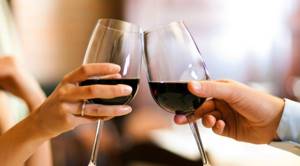
Dry wine is low in calories
Beer lovers shouldn’t be upset either, since their favorite drink contains hops, which help relieve stress and nervousness, calm you down and help improve sleep. Light varieties are quite acceptable, even if you adhere to a diet. The calories contained in 2-3 glasses drunk are not so great. But you should pay attention to the alcohol content. The strength should not be more than 5-6%. It is better to exclude dark varieties with a large amount of alcohol, as they are higher in calories. Very useful is the ability of beer to remove excess fluid from the body, which is negated by the abuse of a variety of high-calorie snacks with beer. They increase thirst and cause the need to drink more than desired. Usually all these dishes are well salted and promote fluid retention. Beer itself does not have much energy value, but snacks will not allow you to enjoy this drink without gaining weight. In reasonable quantities, this alcohol will not harm the body.
Strong alcohol
Stronger alcoholic drinks also have a number of beneficial properties. This applies to all kinds of balms and tinctures. All of them are infused with medicinal herbs and have a healing effect. Only they should be used differently; they are added in small quantities to tea or coffee, or taken as directed before or after meals.
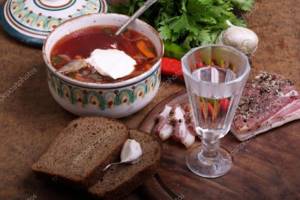
Vodka is higher in calories compared to beer and dry wine
A glass of whiskey, vodka or cognac will help activate your brain and invigorate you after a hard day. Sometimes a little alcoholic drink is recommended as a means of preventing colds, since it has a good warming effect. Just don’t forget that these alcoholic products are much higher in calories than wine and beer. Vodka is considered almost pure alcohol, and its energy content is very high.
Champagne is also worth mentioning. This sparkling wine may not be sweet at all, such as brut. In terms of calories, it is the lowest among its counterparts. One glass of good dry champagne will bring undoubted pleasure and will not affect your figure. The quality and quantity of what you drink should depend on how many calories are in alcohol.
How to drink and not gain weight
It would seem, what calories are in alcohol?
What does it contain besides alcohol? Many people sincerely do not understand where the connection is between alcohol and calorie content. And the connection is direct: almost every drink with “degrees” is created by fermentation. That is, using sugar.
And many alcoholic drinks are confidently ahead of buns and sweets in terms of calorie content. How many calories are in alcohol, and is it compatible with diets?
As you know, everything is good in moderation. And when it comes to alcohol, this measure should be divided in half and “given to the enemy” - the body will be healthier. Of course, a glass of wine won’t cause a disaster, but it’s better to ask in advance how many calories are in your glass (shot) if you’re struggling with extra centimeters.
The energy value of alcohol is 7 kcal/1 g. That is, even more than in protein and carbohydrate products. But unlike them, “alcohol” calories are completely empty.
If food plays the role of “fuel” for the body, then alcohol does not make any contribution to metabolism at all. For example: ½ bottle of wine is about 30% sugar (in kcal) and 270% alcohol. Banana milk with bran will provide us with the same 300 kcal.
Only in the second case do we get fiber, iron with calcium and proteins, and in the first - exclusively calories.
How many calories are in alcohol? Everything is simple here: the higher the degree, the higher the numbers.
Champagne
The classification refers to the amount of sugar in the composition. For example, brut contains little or no sugar.
- Sweet: 90 kcal/100 g.
- Semi-sweet: 88 kcal/100 g.
- Dry: 65 kcal/100 g.
- Semi-dry: 78 kcal/100 g.
- Brut: about 55 kcal/100 g.
- White dry: up to 76 kcal/100 g.
- Red dry: up to 68 kcal/100 g.
- Semi-dry: up to 78 kcal/100 g.
- White, dessert: about 153 kcal/100g.
- Cahors, red - up to 147 kcal/100 g.
- Kindzmarauli, red: about 172 kcal.
- Strong: 163 kcal/100 g.
- Sweet: about 100 kcal/100 g.
- White, semi-sweet: 78 kcal/100g.
- Red, semi-sweet: up to 70 kcal/100 g.
- Light, 1.8%: up to 29 kcal/100 g.
- Light, 2.8%: up to 37 kcal/100 g.
- Light, 4.5%: up to 45 kcal/100 g.
- Dark: 54.6-60 kcal.
- Regular: up to 250 kcal/100 g.
- Rice: up to 250 kcal/100 g.
- Tequila: 274 kcal/100 g.
- Anise: 297 kcal/100 g.
- Sake: 134 kcal/100 g.
Other drinks
- Absinthe: up to 83 kcal/100 g.
- Rum: about 375 kcal/100 g.
- Liqueurs: 112-325 kcal/100 g.
- Liqueur (cherry): 300 kcal/100 g.
- Calvados: up to 325 kcal/100 g.
- Gin: 225 kcal/100 g.
- Mulled wine: 80-85 kcal/100 g.
- Whiskey: about 300 kcal/100 g.
- Punch: 260-350 kcal/100 g.
- Madera: up to 170 kcal/100 g.
- Vermouth: 139-150 kcal/100 g.
- Cognac: about 240 kcal/100 g.
- Brandy, 40%: up to 225 kcal/100 g.
- Ethyl alcohol: about 710 kcal/100 g.
- Schnapps: up to 200 kcal/100 g.
- Energy drinks: about 80-90 kcal/100 g.
We can talk about the insidiousness of alcohol not only from the point of view of its calorie content. Among other things, it also whets the appetite. After a glass of beer you will definitely want to crunch, for example, crackers. And a glass of wine won’t be as enjoyable without fish, olives, cheese or fruit. The result: an explosive mixture that negates all your efforts in a day (or even a week).
It is also worth remembering that the body primarily uses alcohol calories. And only lastly - grocery. That is, the body burns the calorie content of the drink, and “hides” the calorie content of the accompanying dishes on the sides.
In what diets is alcohol allowed - to drink or not to drink?
As we noted above, diet and alcohol are incompatible. But some diets still allow its consumption in reasonable quantities.
- Kremlin diet. She allows drinking 1 glass of red wine - no more than once a week, in the middle of lunch. A categorical ban on liqueurs and beer, champagne and sweet/semi-sweet wines, and liqueurs.
- Ducan's diet. Alcohol consumption is permitted only when preparing food. For example, for sauces that are light in fat content - for flavor. Or for other dishes - no more than 3 tbsp of wine and provided that you cook without a lid.
- Mediterranean diet. 1 glass of dry wine is allowed in the middle of dinner or lunch.
- Sonoma Diet. At the 3rd stage of the diet, moderate consumption of wine is acceptable - no more than 1-2 glasses/day. But only noble reds! For example, Syrah, Merlot or Cabernet Sauvignon.
- Express diet. For those strong in spirit. This 3-day diet involves drinking 200 ml of dry white wine three times a day with meals (cheese, bread).
- Champagne diet. In this option, 2 glasses of champagne per day (dry) are allowed.
- Buckwheat diet. 1 glass of dry wine is allowed. Not every day - only sometimes.
- Chicken diet. In this weight loss regimen, no more than 1 glass of light alcohol per day (dry wine or light beer) is allowed.
- Atkins diet. It allows the consumption of wine in tiny portions at any stage except the first.
- Diet - what alcohol is allowed and in what quantity?
- No matter what diet you are on, it is better to eliminate alcohol completely.
- If you can’t do without it, then without harm to your figure it is permissible to:
- No more than 50 g of strong drinks, 350 ml of beer or 100-200 g of light drinks per day.
- Choose a light type of beer with a minimum of “turnover” or dry wines (brut is better).
- You should not consume alcohol with high-calorie or salty foods.
- The goal of the diet (or rather, one of the goals) is to speed up metabolism. Alcohol slows down your metabolism. That is, fat burning occurs slowly or does not occur at all.
- Every meal accompanied by alcohol consumption is deposited in the “bins” of the body.
- Alcohol increases appetite. Accompanying dishes should contain a minimum of carbohydrates and calories.
- Fewer degrees means lower calorie content. Dilute wine with ice or water.
- Drink in small sips - not in one gulp and only on a full stomach (while eating).
- If you are planning a party (holiday), then start reducing the number of calories in your diet in advance.
How much to drink is a personal matter for everyone. But the norm for the drink is no more than 50 g/day. If the norm is exceeded, alcohol becomes poison for the body.
Finding information about whether you can drink alcohol while following a diet is difficult. You have to rack your brains in search of answers to questions regarding drinking alcohol, losing weight, and effective training. There are especially many questions when you want to drink without harming your figure, that is, they are looking for the lowest calorie alcohol.
Consider drinking alcohol while dieting - a key task. There will also be a table from which you can find out how many calories and what kind of alcohol it contains.
There can be no question of an unequivocal ban on alcohol consumption for those wishing to lose weight. But its consumption should be kept to a minimum, since exceeding the dose will harm the process of losing excess weight. This is connected not so much with the calorie content of alcohol, but with its effect on the body.
Important! The common belief that there is diet alcohol is completely wrong. All alcohol contains calories. You just need to choose the lowest calorie alcohol.
Let's figure out why you shouldn't drink while losing weight. Alcohol has a suppressive effect on the functioning of the cortex and subcortical areas of the brain. These areas are responsible for volitional behavior, the ability to think critically and make decisions.
After drinking alcohol, the ability to control thinking and actions is impaired, which is why instinctive behavior is disinhibited - aggression appears, libido and the feeling of hunger increase.
Therefore, being intoxicated, you can easily eat too much.
We suggest you read What to do in case of alcohol poisoning at home
Alcohol is dangerous even the day after consumption. This is due to the formation of a hangover syndrome - many people experience a pronounced feeling of hunger. The condition develops due to individual characteristics of dopamine metabolism in the brain.
Alcoholic products contain a certain amount of calories. At the same time, each one is individual. It is a mistake to think that vodka is the lowest calorie alcohol. It contains a supply of calories almost equal to that of bread.
It is definitely not recommended to consume alcoholic products while playing sports. Below are reasons why you should not drink when losing or gaining weight:
- alcohol disrupts the functioning of the cortex and subcortex;
- alcohol (especially strong) disrupts the absorption of nutrients;
- alcohol interferes with the formation of protein molecules necessary for muscle growth;
- alcoholic products negatively affect the production of gastric juice, which is why food cannot be fully absorbed;
- alcohol destroys the cells of the pancreas, which secretes enzymes necessary for digesting food;
- when absorbing ethyl alcohol, fat burning processes are disrupted;
- for the absorption of alcohol, a significant amount of enzymes that bind it is necessary, the release and operation of which requires effort from the body;
- Alcohol negatively affects the state of the nervous system and heart.
Important! Each person has their own sensitivity to alcohol, which is why the negative effects of drinking vary from person to person. Therefore, drinking alcohol, even the lowest calorie one, is not recommended.
This refers to a dose at which the harm from use does not exceed the benefits. Despite all the disadvantages, drinking alcohol can have a positive effect on your health:
- blood pressure decreases;
- blood flow in vessels, especially small ones, increases;
- the transmission of nerve impulses accelerates;
- metabolism increases, etc.
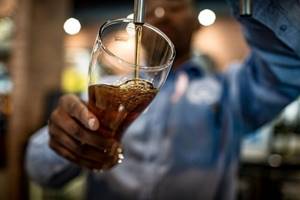
Important! Only high-quality alcohol in small quantities can bring benefits. In other cases, alcohol harms the body.
Consuming alcohol-containing products at a compatible dose will allow you to drink profitably. Especially in situations where it is impossible to refuse. However, the compatible dose is individual for everyone.
Excessive alcohol consumption contributes to weight gain - another reason why you should not drink while on a diet. Alcohol also leads to dehydration. Not only water reserves are lost, but also nutrients necessary to maintain metabolism at a stable level.
Weight gain when dehydrated occurs due to:
- A compensatory mechanism for weight gain - after the loss of water and nutrients, with their subsequent normal supply, a reserve is created in case of a recurrence of a dangerous situation. Reserve reserves are formed due to fat deposits.
- Reducing metabolic activity due to liver dysfunction is the most dangerous process.
- Simple classic advice not only for those losing weight - reduce the dose. No more than 50 ml of strong alcohol, 250 ml of wine, 350 ml of beer. While you're losing weight, you won't run out of alcohol. Honestly. Throw off what you've drunk and drink.
- Control the quality and quantity of snacks. Avoid “heavy” foods, choose low-fat cheeses, white meat, vegetables, olives. Give preference to easily digestible foods. For example, different types of fish - it is digested almost at the speed of sound.
- Try to drink strong drinks after your main meal. This will allow you to control the situation: this way you won’t turn into trash in a matter of minutes and won’t overeat.
- The stronger the alcohol, the more calories it contains. Consider this when choosing an alcoholic drink. A couple of glasses of wine are better than 150 ml of vodka.
- Put an end to cocktails, because cocktails are a universal evil. They contain tons of sugar and sweet tonics, and you can’t control the quality of alcohol in the bar.
- Give up liqueurs. Baileys and his brothers are no longer your friends because they are the most calorific of the whole list. Again, the ubiquitous sugar is to blame.
- Choose drinks with a high tannin content. They are absorbed more slowly in the stomach. Red wine, not white, dark beer, not light, cognac, rum, whiskey, not vodka.
Calorie content of alcoholic drinks
In order to successfully keep in shape and not gain excess weight in a short period of time, you need to know which alcohol contains the fewest units. When deciding on your choice, it is worth considering what the sugar and pure alcohol content is in this product. Each type of alcohol has different values for these indicators. The dependence is simple: the sweeter and stronger the drink, the more calories it contains.

Less calorie dry champagne
The following drinks can be classified as the lowest calorie:
Dry white and red wines are low in calories (within 65-70 kcal).
Semi-dry wine already contains about 75-80 kcal.
Light beers contain the fewest calories (about 60 kcal). The main problem is that beer drink is usually consumed in much larger volumes than strong alcohol (1 bottle has at least 250 kcal).
Dry champagne. This sparkling wine has very few calories - no more than 85.
The wines are semi-sweet and sweet. These drinks already contain about 90-100 kcal.
Dark beer and ale are considered the most high in calories - about 500 kcal per bottle.
Semi-sweet champagne approximately 120 kcal.
Strong alcohol. The calorie content of whiskey, vodka, brandy or cognac is 240-250 kcal.
Cocktails and liqueurs have an energy reserve of 300 kcal.
What is preferable - beer or vodka? Everything is decided by the amount of drink. If you give the palm to vodka, then you need to remember about its rather high energy content. Any extra stack will add calories. Every alcoholic product has calories. For beer it doesn’t seem to be very large, but in terms of 3-4 bottles it will be no less than in strong alcohol.
It is very difficult to answer unequivocally the question of which alcohol does not make you fat. Everything is very individual. The main rule: observe moderation in everything. Under no circumstances should you get carried away with alcohol, otherwise there will be no benefit and your weight will be higher than normal.
Cognac, 225 kcal
Such noble drinks as brandy or cognac are usually savored little by little, like a delicacy, so there is no risk of going overboard on calories. The recommended dosage per day is no more than 50 ml. Vodka, whiskey, tequila, rum and other forty-proof drinks have approximately the same calorie content.
Benefits of “Pate”: one of the leaders in calorie content is Van Gogh’s favorite absinthe. 300 units per 100 ml. But the percentage of alcohol in it can reach 85%. Therefore, if you dilute 50 ml of green potion with several ice cubes, then it can be chosen for evening gatherings with friends.




